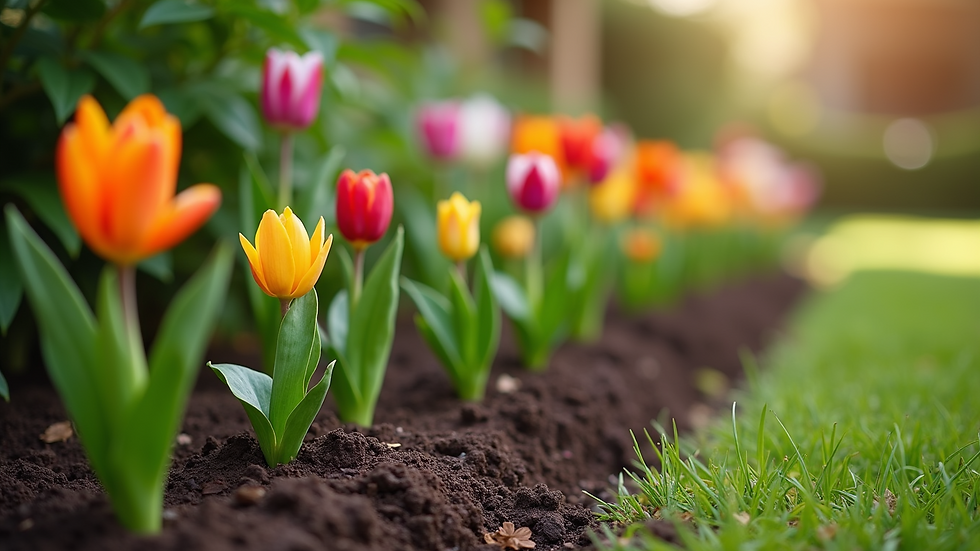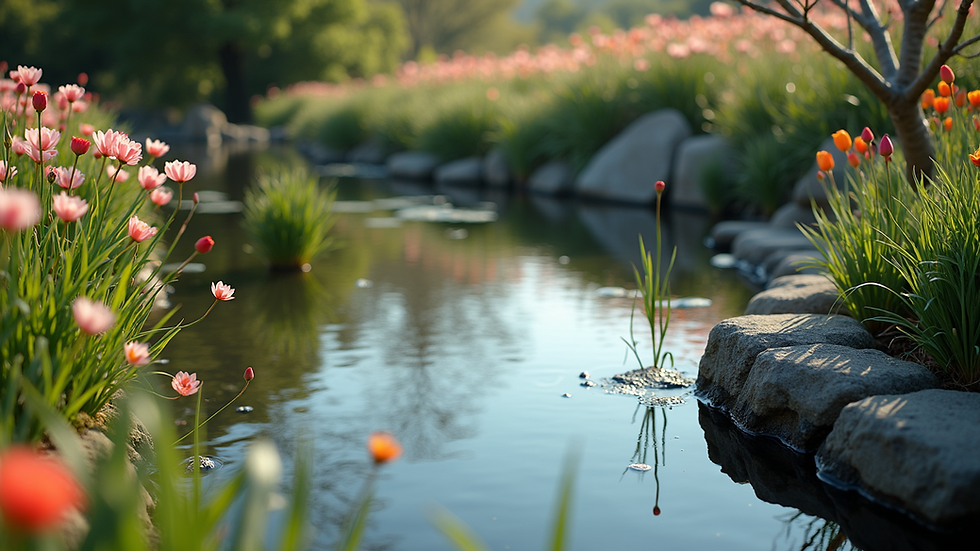Spring into Action: Must-Do Gardening and Pond Care Tips for an Epic Season
- Aidan Hall
- Apr 19
- 4 min read
Spring has arrived, bringing the promise of fresh growth, vibrant colors, and the joy of tending to your garden and pond. As the days stretch longer and warmer, it’s time to get into action and revitalise your green spaces. This season is all about breathing new life into your garden and pond, ensuring they thrive in the months ahead. Whether you are a seasoned gardener or just starting out, the following tips and tricks will help you maximise your spring gardening and pond care efforts.
Essential Spring Gardening Jobs
As the frost melts and the soil warms up, your garden is ready for action. Here are some crucial spring tasks to complete:
1. Clean Up Your Garden
Start by giving your garden a thorough cleanup. Remove dead leaves, old plant debris, and any stubborn weeds that survived the winter. This not only boosts the garden's appearance but also lowers the risk of pests and diseases. For example, getting rid of last year's debris can reduce the chance of aphids, which can cause significant damage to new growth.
2. Prepare Your Soil
Healthy soil is a gardener's best ally. Conduct a soil test to check the pH and quality. Most plants flourish in slightly acidic (pH 6.0 to 6.8) to neutral soils. Enrich your soil with compost, aged manure, or peat moss to enhance its structure and nutrient content. For example, incorporating 2 to 4 inches of compost can improve soil fertility and structure significantly.
3. Planting Time
Once your soil is ready, decide what to plant. Choose spring flowers, vegetables, and herbs suited to your climate. Good options include pansies and snapdragons for flowers, while vegetables like spinach and radishes are ideal for cooler temperatures. For instance, if you plant radishes now, you can expect to harvest them in about 3 weeks.
4. Pruning and Deadheading
Spring is an excellent time to tackle overgrown shrubs and trees. Prune dead or woody stems to encourage fresh growth. For example, removing spent blooms from plants like daffodils can lead to more flowers later in the season. This practice helps maintain plant vigor and promotes a more abundant bloom cycle.
5. Mulching
Once you’ve planted, add a layer of mulch around your plants. Mulch conserves moisture, curbs weed growth, and stabilises soil temperature, fostering overall plant health. A 2 to 3-inch layer of mulch can significantly reduce water evaporation, saving you time and effort in your watering routine.

Spring Lawn Care
Your lawn needs just as much attention as your garden. Spring is the perfect time to rejuvenate a tired lawn and encourage dense green growth. Here’s what to do:
1. Assess and Repair
Take a close look at your lawn. Identify bare spots and areas affected by winter damage. Reseed these spots with a grass seed that matches your existing lawn—typically, a mix of Kentucky bluegrass and perennial ryegrass is a safe bet for many regions.
2. Aerate
Aeration plays a vital role in promoting root growth by loosening compacted soil. Use a lawn aerator to create small holes, allowing air, water, and nutrients to reach the roots. Studies have shown that lawns treated with aeration can improve root density by more than 75%.
3. Fertilisation
Spring is the ideal time to feed your lawn. Apply a balanced, slow-release fertiliser to ensure your grass gets the nutrients for vigorous growth. For instance, a nitrogen-phosphate-potassium (N-P-K) ratio of 20-5-10 is beneficial for most lawns.
4. Mowing
As your grass starts to grow, set your mower blades higher, ideally to about 3 inches. Taller grass promotes deeper root systems and helps your lawn resist drought. Mowing regularly at this height can keep your lawn lush and green.
5. Watering
Now is the time to adopt effective watering habits. Water deeply but less frequently to encourage deep root growth. Early morning is the best time to water, reducing evaporation and preventing disease. Aim for about 1 to 1.5 inches of water per week, adjusting based on rainfall.
Pond Care in Spring
As your garden flourishes, so should your pond. Spring is a busy time for pond maintenance to ensure clarity and health throughout the warm months. Follow these important steps:
1. Remove Debris
Start by cleaning out fallen leaves, branches, and other debris from your pond. This helps keep the water clear and minimises algae growth.
2. Clean Your Pond
If your pond has a buildup of sludge or algae, use a pond vacuum or skimmer to clear it out. Keeping your pond clean supports fish health and enhances its visual appeal. A clean pond can also boost oxygen levels, positively affecting your aquatic life.
3. Inspect Pond Equipment
Examine your pumps, filters, and any other equipment to ensure they are in working order. Replace any worn parts as needed, and clean filters to maintain optimal water circulation.
4. Monitor Water Levels
As temperatures rise, monitor your pond's water levels closely. Factors like evaporation and the needs of plants and fish can impact water levels. Be prepared to top up the water, preferably using dechlorinated or rainwater when possible.
5. Introduce Plants and Fish
Spring is also the best time to introduce new aquatic plants and fish into your pond. Choose plants that provide both cover and oxygen for fish, such as water lilies and cattails. When introducing fish, acclimatise them slowly to help reduce stress and improve their chances for a healthy transition.

Get Ready To Get Your Hands Dirty
With a bit of effort and enthusiasm, you can turn your garden and pond into stunning outdoor spaces this spring. By focusing on these key tasks, you will not only enhance the beauty and utility of your garden but also create a thriving ecosystem for plants and wildlife.
So, slip on those gardening gloves and prepare to spring into action! Embrace the gardening season with renewed energy and a steadfast commitment to keeping your spaces flourishing throughout the year. Whether you're caring for your lawn or nurturing your pond, these tips will help you enjoy every moment outdoors.
Happy gardening and pond care!




Comments